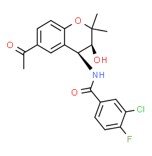InflammX Clinical Candidates and Indications
Xiflam™
Xiflam is a novel small molecule which was developed 20 years ago and abandoned due to evolving priorities by a large Pharmaceutical Company. 20 years ago the inflammasome had not been discovered and was not known as a therapeutic target. InflammX subsequently identified Xiflam as a potent inhibitor of the pathological Cx43 hemichannel. InflammX has licensed the IND enabling preclinical toxicology, pharmacology, carcinogenicity and CMC data. In addition a clinical safety database has been generated from more than 1000 patients in multiple Phase 1/2 clinical studies. Patients were dosed for up to 3 months at doses from 25mg to 80mg. These studies show Xiflam to be well tolerated with no safety concerns. The drug product is formulated into a tablet for QD oral administration. Xiflam has oral Tmax absorption 0.5 - 3 hours, plasma T1/2 30 – 40 hours (no accumulation), linear PK between 2 and 40mg with proportional increases in Cmax and increase in CNS concentration in parallel with serum levels (meaning it crosses the Blood Brain/Blood Retinal Barrier). There is no change in elimination half life with increasing dose and low inter subject variability. Furthermore, Xiflam has a clear toxicity profile, no cardiovascular, renal or respiratory effects, and two year carcinogenicity studies have been completed. Xiflam has a clear dose response curve with minimum dose established, and plateauing at higher doses. It has a wide dose concentration window and no significant upper dose adverse effects.
Additionally radiolabeled whole body studies after a single dose orally administered, show high bioavailability peaking at 6 hours with trace drug still evident at day 3. Importantly the bioavailability in the uveal tract (representing drug concentrated in the iris, ciliary body and the choroid/retina) was high and essentially the same as in the kidney.
InflammX has carried out significant pre-clinical in vitro studies definitively demonstrating the mechanism of action.
Additionally studies have been undertaken in a phenotypical model of dry AMD (GA) and a rat model of Diabetic Retinopathy. The rat model was unique in that the rats were born with diabetes and exhibited signs of diabetic retinopathy (micro and macro aneurysms) at 4 weeks. The studies in both of these models of disease showed both structural and functional efficacy in the Xiflam treated groups compared to placebo controls.
In a diabetic challenge model in human ex-vivo retina, and in human retinal pigment epithelium and endothelial cell models, Xiflam stops ATP release, preventing inflammasome complex assembly and significantly reducing the release of multiple inflammatory cytokines including Il-1b, Il-18, IL-6, IL-8, sICAM-1 and VEGF.

